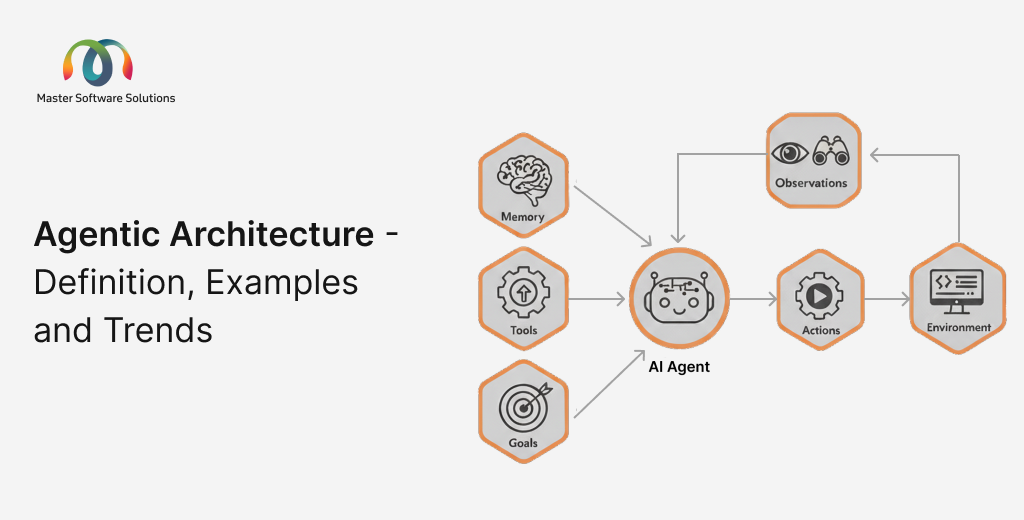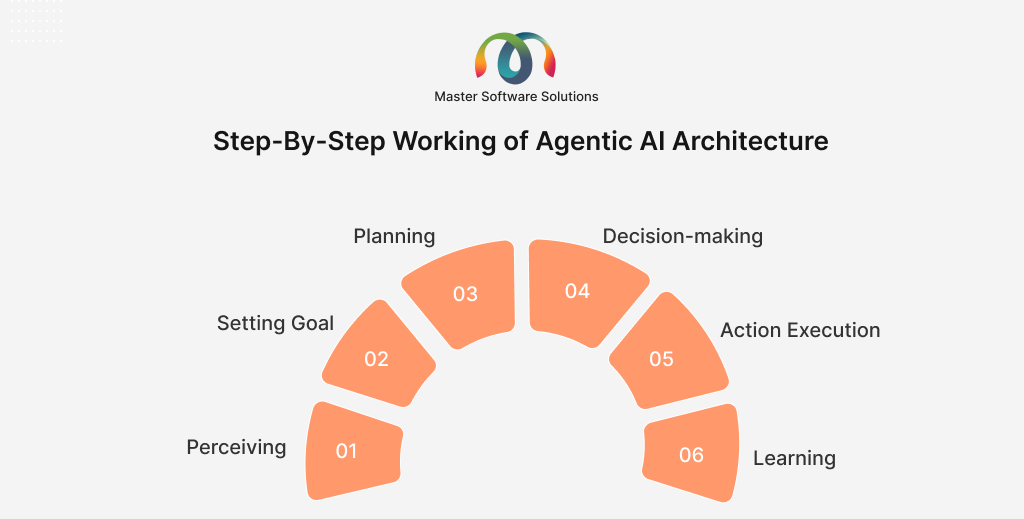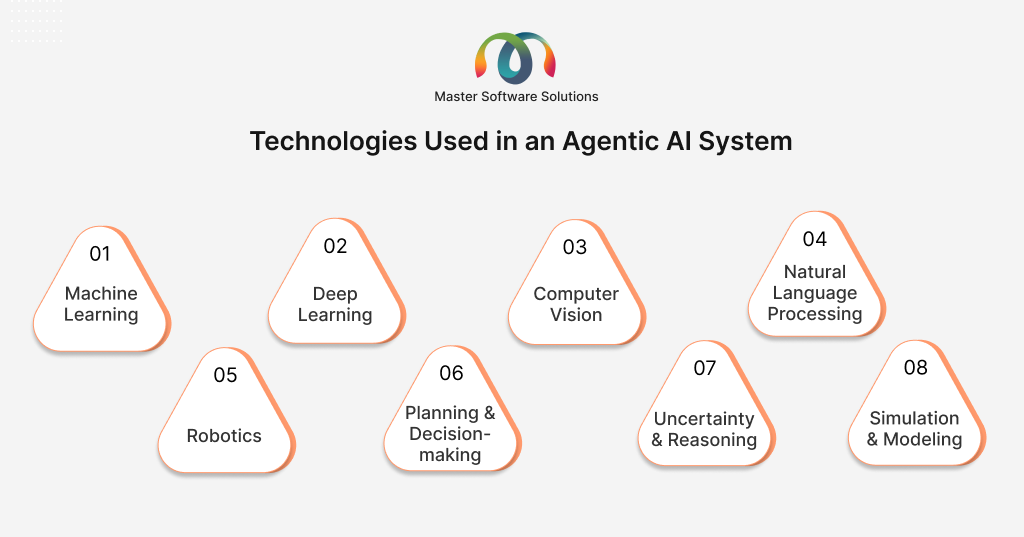Agentic AI is built of multiple AI agents that use large language models (LLMs) and complex reasoning to act autonomously, adapt in real-time, and solve multiple-step, intricate problems. Leveraging multiple AI agents enables them to enhance their decision-making abilities and understanding of natural language.
This blog explores agentic architecture with examples and the latest trends.
What is agentic architecture?
Agentic architecture refers to the framework on which AI systems are designed to create intelligent agents to adapt to the changing environment, perform tasks autonomously, and make informed decisions. They use planning, memory, reflection, and actions to achieve the desired outputs.
Agentic AI uses AI agents to perform tasks for users or other systems. These agents are adaptive and can navigate through dynamic environments to achieve desired results. The agentic AI architecture aims to provide a structure for large language models to automate task completion.
How does agentic architecture work?
Agentic architecture is composed of components to address the core of an agent, including Planning, Thinking, Self-reactiveness, and Self-reflectiveness. They provide a base to AI agents for setting goals, planning, monitoring performance, and reflecting to reach a specific goal. Step-by-step working of agentic AI architecture:
Perceiving
The AI agent receives input from the environment. Relevant information is extracted from the input, including visual features, textual information, or numerical values.
Setting goal
The cognitive module of the AI agent defines its goals (explicit or implicit goals).
Planning
The AI agent creates a line of action based on the goals and the current situation. Planning can involve steps or a hierarchical structure of sub-goals.
Decision-making
AI agents analyse available options and select the most appropriate action depending on their goals, plan, and present situation.
Action execution
The agent executes the action as determined. It may include physical or virtual action depending on the use case.
Learning
Agents can update their knowledge and improve their performance. This includes reinforcement learning, supervised learning, or unsupervised learning.
Components of agentic AI architecture
AI agentic systems consist of four interconnected types of components of agentic architecture. Each component plays a crucial role in seamless AI agentic functioning. The components of agentic AI architecture are:
Perception module
The perception module refers to a sensory system that gathers and interprets data from its environment. It is a foundational module on which the agent defines its goal. The agent receives input from various sensors, including cameras, microphones, tactile sensors, and digital data sources. It processes this raw input to extract meaningful data for decision-making. The agent can identify objects and entities in the environment, using computer vision, NLP, and ML.
Cognitive module
This is the brain of the AI agent, where it defines its goals, plans, and makes decisions based on the interpreted input. The cognitive module is responsible for defining goals and objectives for the agent. It can create strategies and plans to achieve defined goals, depending on the capabilities and environmental situation. This module helps agents choose the best action.
Action module
This module is responsible for taking actions as determined by the cognitive module. It interacts physically or virtually with the environment to implement the action. They control physical and virtual actions through actuators, like motors, speakers, or cameras. The agent executes the action.
Continuous improvement and learning
The agents continuously learn and improve over time as they interact with their environment and gather data. There are various techniques, including reinforcement learning, supervised learning, and unsupervised learning that enable AI agents to continuously learn and improve.
- Reinforcement learning – Agent learns through rewards and penalties.
- Supervised learning – Agent learns from labeled data, making it effective for decision-making.
- Unsupervised learning – Identify patterns and relationships in data without the need for labels, enabling it to adapt to the situation and improve its behavior.
Technologies used in an agentic AI system
Agentic systems follow two fundamental configurations, including single-agent and multi-agent architectures. They generally leverage machine learning models and computational methods to execute the sense-plan-act cycle for effective decision-making and automation.
Machine learning
Agents rely on machine learning (ML) algorithms to learn and understand data to improve their performance. They are used for various tasks like classification, regression, and clustering, contributing to the ability of an agent to understand its environment and user input. They enable agents to learn from experience, adapt to new situations, and improve performance.
Deep learning
It includes convolutional neural networks (CNNs) that can process complex sensory data like images and video (in computer vision). Agents use recurrent neural networks (RNNs) and the Transformer to understand sequential data like speech and text (in natural language processing). This enables agents to perceive and interpret their environment.
Computer vision
It enables AI agents to “see” and interpret visual information from the cameras and other sensors. Computer vision is important for tasks like object detection, recognition, scene understanding, and tracking in robots, autonomous vehicles, and surveillance systems.
Natural language processing
Enables agents to understand and process human language for interaction through text or speech. These tasks include natural language understanding, dialogue management, and question answering. It is used to extract information from text, understand instructions, and even generate plans or explanations in human language.
Robotics
It provides an embodiment for agents to interact with the real world. Robotics involves sensors for perception (cameras), actuators for taking actions (motors or manipulators), and control systems to coordinate movements.
Planning and decision-making
This enables agents to define goals, formulate plans, and make decisions about actions in various environments to achieve their desired goals. The process involves searching through various possibilities for action sequences and evaluating potential outcomes. Smart planning is important for agents to manage resources effectively.
Uncertainty and reasoning
It empowers agents to operate effectively even with noisy or incomplete information. Agents use techniques from probability, statistics, and logic to model uncertainty and perform reasoning under uncertainty. Agents can assess potential risks associated with different actions and make more informed decisions.
Simulation and modeling
This provides a virtual environment to train and evaluate agents safely and efficiently before deploying in the real world. It is essential, especially for complex and risky tasks, like autonomous driving or robotics. Modeling allows agents to use models of the world and use them to predict outcomes of their actions and reason about complex situations. Simulations generate large labeled datasets to train perception systems such as computer vision, which can be expensive or difficult to obtain in the real world.
Difference between agentic and non-agentic
Agentic and non-agentic AI systems differ fundamentally in their operational ability associated with dependency and decision-making.
Agentic AI
Agentic AI has a high degree of autonomy, unlike non-agentic AI. Once the task is defined, they can plan, strategize, and execute actions independently to achieve the goal. Characteristics of Agentic AI systems:
- They can make complex decisions based on their understanding of the context, information available, and learned experience.
- They can analyse various lines of action and choose the one with the optimal course of action.
- Agentic AI systems are goal-oriented, which means they are driven by specific objectives and actively work to achieve them rather than just reacting to the immediate inputs.
- They can learn from their past interactions and experiences to easily adapt and improve their performance over time.
- These agents can anticipate needs and take proactive steps without specific prompting.
- They can handle complex, multi-step tasks that need reasoning, planning, and coordination.
- Agentic AI systems can interact with other AI agents, systems, and even humans to collect information, collaborate, and refine their understanding.
Examples of agentic AI systems are: autonomous vehicles, AI-powered personal assistants, smart home systems, robotics in manufacturing and logistics, financial trading bots, and AI for drug discovery.
Non-agentic AI
Non-agent AI systems, unlike agentic AI systems, need direct instructions or specific prompts for each task. They are more like a responsive tool that responds when given an instruction. Characteristics of non-agent AI systems are:
- They react to the inputs and execute pre-defined rules or algorithms.
- Non-agentic AI systems are designed specifically for well-defined tasks.
- They can learn from the data to improve their performance. However, they can not adapt their overall behavior or goals.
- They need human input to initiate actions and make decisions outside their scope.
Examples of non-agentic AI systems are: traditional chatbots, image recognition software, recommendation algorithms, spam filters, and basic automation scripts.
Agentic AI applications across various industries
Healthcare
In healthcare, agentic AI can help you provide personalised patient care and diagnostics. They can analyse patients’ medical data, assist in diagnosis, recommend treatments, and even monitor patients’ health in real-time. Agentic AI can help you:
- Handling appointment scheduling, insurance verification, billing, and medical record keeping.
- Analyze medical images (MRI or CT scans) quickly with accuracy, assisting in early disease detection.
- Accelerate potential drug candidate identification and simulate clinical trials.
- Help in remote patient health monitoring to detect irregularities and alert healthcare providers for timely interventions.
- Identify critical health conditions like cancer or cardiovascular diseases in the early stages.
- Automate document reviewing, discrepancy detection, and ensure compliance.
Finance
In the financial sector, agentic AI systems are used for predictive analysis and automated trading. Agentic AI systems can help you:
- Analyze transaction patterns and identify anomalies to detect fraudulent activities in real-time.
- Enhance credit scoring models, evaluate investment risks, and ensure regulatory compliance.
- Offer 24/7 support through smart chatbots and virtual assistants for complex queries and personalized advice.
- Analyze market data to provide investment ideas and automate trading on pre-approved strategies.
- Provide real-time insights for better resource allocation and growth strategies.
- Identify trading opportunities and autonomously execute trades based on real-time analysis.
Customer service
Agentic AI systems are intelligent tools to enhance your customer service. Ways in which agentic AI systems help improve customer service are:
- Engage with customers to resolve specified customer issues beyond FAQs.
- Organizing and retrieving data to provide accurate and personalized support.
- Analyze customer preferences to provide customized product suggestions.
- Automate handling customer data management, project management, and other administrative tasks.
Supply chain
Integrating agentic AI systems into the supply chain can help you streamline and optimize the entire supply chain. Agentic AI can optimize and enhance resilience in the supply chain operations through:
- Analyze sales trends, market influences, and external factors to anticipate future demands and manage inventory levels.
- Analyze supplier performance, contracts, and market pricing to make the best sourcing decisions.
- Agents can analyze traffic, weather, and delivery schedules to determine the most efficient transportation routes.
- They can monitor the condition of the vehicle and predict potential failures, and schedule proactive maintenance.
- Create a digital twin of the supply chain to simulate disruptions and identify risk control strategies.
- Monitor data streams to identify irregularities and flag potential disruptions.
- They can help you streamline creating invoices, manifests, and other essential documents.
- Adjust pricing based on real-time market analysis to maximize revenue.
Conclusion
Integrating an agentic AI system with your business operation can help you improve efficiency, productivity, and profitability. Investing in AI might seem expensive at the time; however, it can bring in long-term benefits and profits.
Master Software Solutions provides end-to-end AI agent development services and 100+ turnkey AI solutions you can directly buy. Our AI agent services include agent consulting, custom AI agent development, AI agent integration, AI agent training and optimization, behavioral modeling, and deployment and scalability. If you also want to develop a custom AI agent, book a meeting to discuss your requirements and see how we can help.


